I got the train down to London from Glasgow, arriving on Thursday evening. Jostled with my bag through the rush hour and finally made it to south London where I was staying, despite a few slip up and I caught the bus driver on a good day, despite my Londoner friends horror stories!

Friday afternoon, May 27th, I made my highly anticipated visit to The Cult of Beauty exhibition currently on at the V&A. This exhibition explores the origins, influence and legacy of the Aesthetic movement from 1860-1900. The Aesthetic movement found its roots in the Art Movement ('art for arts sake'), it was a departure from the cloying historicism (Gothic/Medieval revival) that was in vogue in the mid-century and dominated interior and decorative arts. The Aesthetic movement was often the brunt of mockery in the popular press, one of the most popular comic operas of the day - Gilbert and Sullivan's The Mikado pokes fun at the aesthetes preoccupation with Japan, such was the craze for everything japonisme. Some famous aesthetes included Oscar Wilde (who went on a lecture tour of America, themed around 'The House Beautiful'), Dante Rosseti, Edward Burne-Jones, William Morris and James Whistler.
Aestheticism in decorative arts is recognizable by oriental motifs and themes, naturalistic themes such as the use of birds (peacock feathers) and flowers (sunflowers), the use of such motifs is heavily symbolic. In furniture, the revulsion towards the heavily decorative High Victorian style is palpable, exotic woods like mahogany were used, and executed in simple forms inspired by Japan (Godwin, for example). Aestheticism spread to dress (rational dress, Liberty & Co.), illustration (Beardsley) to poetry (Yeats). Aestheticism was a way of life, not merely a 'style'. It is linked to Pre-Raphaelitism and Arts and Crafts.
Some of my favourite pieces, in the running order of the exhibition (more or less) -
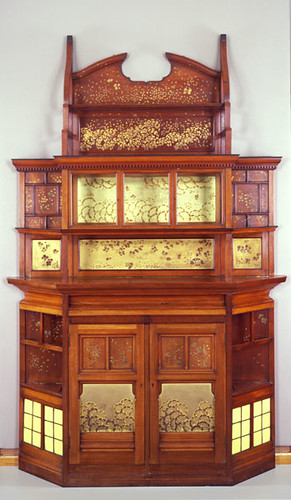
The Butterfly Cabinet (1877/78), James McNeill Whistler and E. W. Godwin, on loan from The Hunterian Gallery, Glasgow.
This mahogany cabinet was designed by Whistler's friend, the architect Edward W. Godwin for the 1878 Universal Exhibition, Paris. Whistler added painted decoration in yellow and gold based on floral motifs and the butterfly, which was Whistler's monogram.
This caught my eye because I had seen it a few months ago in its permanent home at The Hunterian Museum at my university (Glasgow).
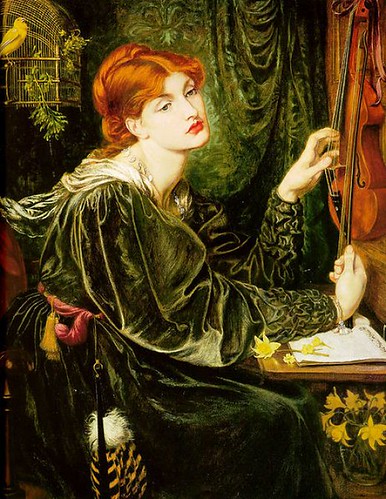
Veronica Veronese, 1872, Dante Gabriel Rossetti
This painting depicts a fictional Rossetti was inspired by the Venetian painters and this is where the female sitter takes her Italianate name from.
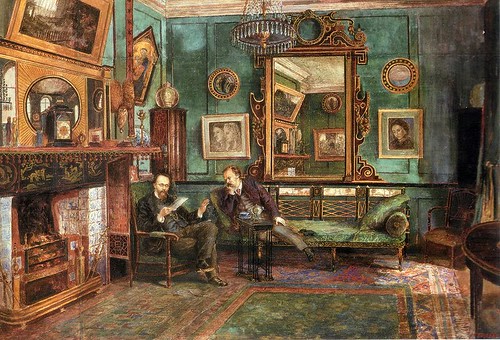
Dante Gabriel Rossetti reading proofs of 'Sonnets and Ballads' to Theodore Watts Dunton in the drawing room at 16 Cheyne Walk, 1882, Henry Treffry Dunn
Gouache

Table, mahogany, 1867-1868, Edward William Godwin
In the Japonisme style, this was one of the most popular and reproduced items of furniture in this style.
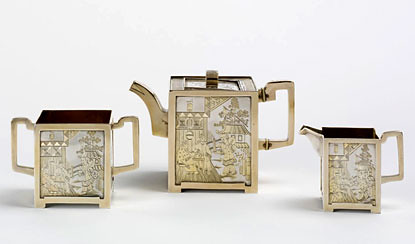
Elkington & Co. (Birmingham), 'Japonisme' teaset, 1886
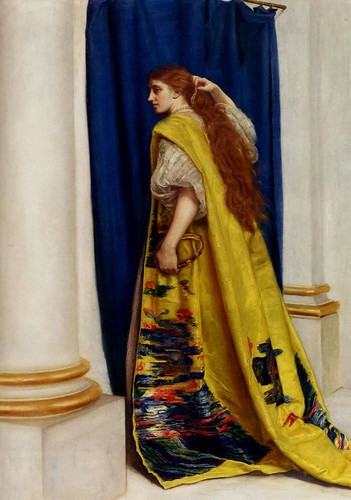
Esther (1865), John Everett Millais
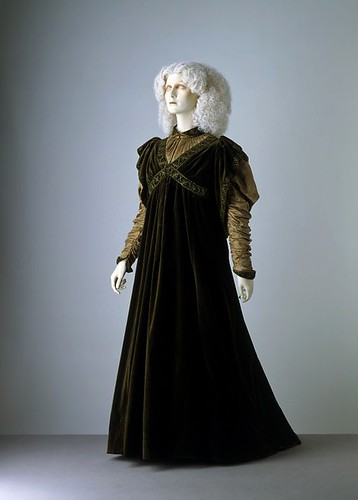
Liberty & Co. tea gown, 1894
Made for one of the members of the Liberty family. Arthur Lasenby Liberty is representative of the self made Victorian businessman. His store did a roaring trade in aesthetic furniture, textiles, etc. This gown conforms to the ideals of the rational dress movement. The gown in aesthetic in style in the historic detailing to the sleeves and bodice, done in a Renaissance style.
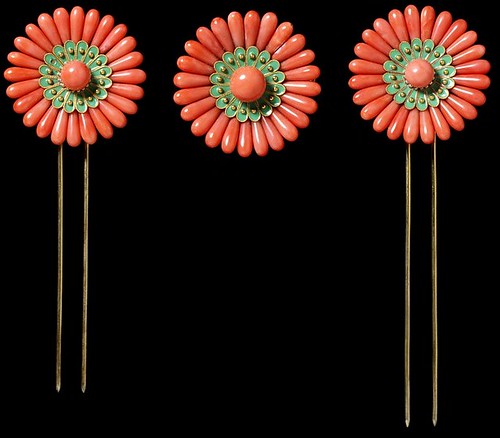
Castellani brooch and matching hair ornaments, 1875-1895
This brooch and the later, matching hair ornaments are thought to have been given by the painter William Holman Hunt to his wife Edith.
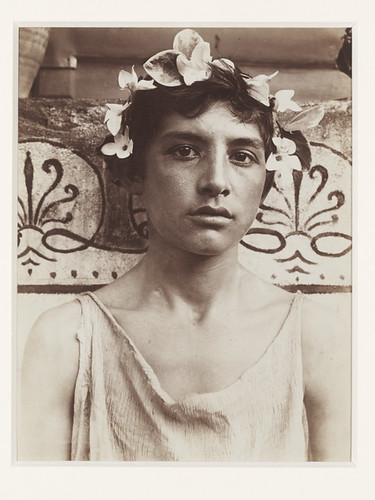
Head of A Sicilian Boy, 1890s, Wilhelm von Gloeden.
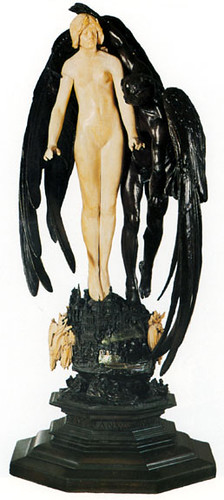
Mors Janua Vitae, 1861, Harry Bates
'Death is the gate of [everlasting] life', Bronze, ivory, and mother of pearl
My only gripe with this exhibition was the audio visual element - they have colourful projections of sunflowers and peacock feathers on the walls which is unusual, eye catching, nothing wrong with that - but I disliked the 'reconstruction' of Whistler's Peacock Room. It was a small circular imitation of a 'room' that you entered into and there are projections of images of Whistler's elaborate decorative murals. It was formally created for the British shipping magnate Frederick Leyland's London home, who wanted a place to showcase his blue-and-white Chinese porcelain collection. I felt it was unnecessary, it broke up the flow of the room it was showcased in - and on a base level, rooms are usually square and it didn't feel like a room when I entered it (so what that was it trying to achieve if not a 'roomy' feel, surely?), it was just a mass of screens with pictures of the room floating around on it, it was disconcerting and didn't seem to be a draw for many of the visitors that were there either.
I loved the peephole that enabled the visitor to 'peep' into a reconstruction of Rossetti's sitting room at 16 Cheyne Walk, this is near the beginning of the exhibition. On the whole, the exhibition was true to the spirit of the movement that inspired it - from the 'greenery-yallery' walls, the variety of exhibits (from photographs to paintings) and the display of 'fine art' alongside decorative arts, as it was intended.
Interesting links
Liberty's window is currently a tribute to the exhibition in the V&A that they played a significant part in
&
Also from the V&A, an interesting blog on the installation of the exhibition - 'Creating the Cult of Beauty'. Great to see how a major exhibition is installed and marketed.*(Edit - 19/6/2012) That blog has now been archived here!
Images via (and copyrighted to) the V&A, The National Portrait Gallery, The Hunterian Gallery Glasgow and the paintings through Google Images. All rights reserved.

Oooh I can't wait to go to this with my dad when he's back from holiday! We're most looking forward to it, and you've made me anticipate it even more.
ReplyDeleteI thought the Peacock room was rather boring actually. And Leighton remains my favourite, so much so that I went to Leighton House the next week. A lot of the items were reconstructions so it was a little disappointing but I still loved his Arabian Bath. I was ecstatic to discover that another of my favourite artists lived in a house across Leighton's backyard. Marcus Stone may have been a Victorian sentimentalist but I love his prints.
ReplyDeleteI wish I knew more about Art. I learn all I know from you!
ReplyDeleteSarah
Garnish with the Bizarre
Cannot wait to see this.
ReplyDeleteOh, I want to fly across the ocean to see this! I swoon for the Arts and Crafts movement. I think I was meant to be a member of the Pre-Raphaelites. Drat, I'm a bit late though. I'm so glad that you were able to see such a gorgeous exhibit. And also a bit jealous but I'm also jealous of the degree you're pursuing. So cool!
ReplyDeleteI've been craving a trip down to London recently to do a bit of a sweep of some of the summer exhibitions and this is definitely increasing the urge.
ReplyDeleteI really love the Henry Treffry Dunn Gouache painting, the cosiness of the room reminds me of the rooms at Charleston (as in the house Vanessa Bell lived in near Lewes) although in this case rather less eccentric.